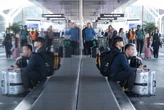When Deborah May decided to grow her Mobile, Alabama home daycare from five children to 10, she had the support of her neighbors, her homeowners association, and even the local planning commission. But in May, the city council denied her plan, with one councilman saying it would put “all neighbors at risk for further encroachment of business into a neighborhood,” NBC 15 News reported.
In Missoula, Minnesota, child care provider BriAnne Moline approached more than 120 property management companies with a thick binder explaining the benefits of home daycares to neighborhoods before she found a landlord willing to rent to her, but only above market price.
And in New York City, where living spaces are notoriously cramped, a number of home daycares are vulnerable to being shut down because they operate out of apartments where no one lives, violating a requirement that providers live in the same spaces as their daycares. Gladys Jones, co-founder of family child care membership group ECE On the Move, knows several women whose programs were shuttered for this reason.
At the mercy of regulators, landlords, and neighbors
The American workforce is suffering a child care shortage which is hitting women the hardest. Mothers report that they’re missing and cutting back on work, getting fired, declining promotions, or giving up the job search because of problems securing affordable, reliable child care. It’s also straining the economy, with one recent study estimating about $122 billion a year in lost pay, productivity and tax revenue due to a dearth of care.
In theory, at least, child care programs run out of residences — called “family” or “home-based” child care — can respond quickly to neighborhood child care needs. After all, unlike building a new child care center, the physical space for these businesses already exists. They’re literally homes.
But in practice, many home daycare providers looking to open or grow programs face a maze of costly, sometimes conflicting laws and regulatory hurdles that have nothing to do with child safety or health, but that can take months and thousands of dollars to fulfill. These might include requirements to provide off-street parking despite daycares having staggered and brief pick-up and drop-off times. Daycare owners are lucky if they make $30,000 a year, said Natalie Renew, executive director of Home Grown, a national initiative to improve access and quality of home-based child care, yet they’re asked “to finance these incredibly expensive capital projects with no reasonable expectation they’ll see that [money] in their operating returns.”
In other cases, home daycares like Moline in Minnesota face discrimination from landlords, condominium groups, and homeowners associations who worry about noise, property damage, and being sued. And there are plenty of top-notch programs operating in a gray area of legality that places them and their clients at the mercy of regulators, landlords, and neighbors.
That was the case in Tulsa, where a neighbor’s repeated complaints led the child care community to discover that about 150 local home-based programs were out of compliance with a city ordinance which required commercial-sized lots for larger programs. At a city council hearing, one provider pointed out that lots that big were not only unnecessary for family child care, it would look “ridiculous,” likely driving down property values.
Oklahoma has since become one of a growing number of states and cities to pass laws and adopt protocols making it easier for licensed home child care to open and grow. In these places, advocates and providers leveraged the intense need for child care to revamp what they say are outdated and discriminatory regulations that do not reflect the realities of the field today. They say it is part of a long overdue reckoning with the outsized role that private residences have taken on in U.S. child care infrastructure, even as home-based child care has often been left out of the policy decisions affecting them.
“Both the providers of home-based care and disproportionately the families that use home-based care are marginalized communities,” said Renew. “They’re Black, Brown, rural and immigrant communities who within our early childhood system and within our society in large are often not not designed for.”
An informal solution turned critical infrastructure
A generation ago, home based daycares were often a way for stay-at-home mothers to make extra money looking after neighborhood kids along with their own. That began to change after it became clear that the United States would not offer public child care and would instead subsidize care only for very poor families. Initially, this subsidized care mostly meant government-funded child care centers run by nonprofits. But in the 1980s, the Reagan administration discovered it could cut costs by encouraging states and cities to give parents vouchers to pay family and friends to help out, or to enroll children in home daycares, as Simon Black, a professor of labor at Brock University, explains in Social Reproduction and the City.
During welfare reform in the 1990’s, several states leaned more heavily on family-based child care programs to provide care for the many children whose mothers were pushed into low-wage work. At the same time, many grandmothers and mothers who had informally looked after their friends’ and relatives’ children also became part of the traditional labor market as part of the welfare to work movement, decimating informal child care supports throughout low-income neighborhoods says Eleanor Luken, who wrote her doctoral dissertation on family child care. With child care centers at capacity and many children left with siblings, or alone, home-based child care programs multiplied in low-income neighborhoods to help fill the void.
In recent years, as child care costs have soared, some home-based daycares in cities including New York and San Francisco have begun catering to middle class families too. They might hire assistants and follow research-backed curriculum. Today, several states offer public preschool for 3- and 4-year-olds in home-based childcare and home-based care is the most common form of licensed care for babies and toddlers. There are about 90,000 official family childcare providers nationwide, though that number has been dropping.
Advocates believe that a reason for this decline is because even as the home-based child care has adapted over the years to fill in gaps for employers, neighborhoods, and the government, the regulations and protocols governing them have not evolved to support them. “It almost seems easier for someone to turn their place into a liquor store than a daycare,” one advocate testified at a 2023 Connecticut hearing. She added that the state’s licensed home daycares could take in 25,000 more children if allowed to expand without red tape.
One common issue is that many states and cities treat “large” or “group” family child care — which might have only three or five more children than a smaller program, along with an assistant — as commercial businesses. Often this means they must apply for costly permits and meet zoning requirements that Renew says do not make sense for homes, such as having hardwired sprinklers.
In a 2021 Harvard Law Review article, Noah M. Kazis argued that this amounts to sex discrimination violating the Fair Housing Act. What distinguishes home daycares from large daycares is “the regulator’s perception that a woman caring for children for money (a prohibited commercial activity) is different from a woman caring for children based on love or family obligation (a permitted residential activity),” a distinction that “ultimately rests on impermissible claims about women’s proper role in society and in the family — not on legitimate land use planning concerns,” Kazis wrote.
Change is happening…slowly
Many lawmakers are starting to take such concerns seriously. California adopted what’s considered the gold standard of such laws. Its 2020 Keeping Kids Close to Home Act prohibits landlords and homeowners associations from banning home daycares. It also zones all family child care with up to 14 children as residences. Programs must continue to meet state child care licensing requirements, including having enough caretakers and meeting fire safety measures. But cities and counties can no longer require additional inspections or permits.
Colorado, Oklahoma, Connecticut, and Pittsburgh have followed suit, zoning all family child care as residences. Meanwhile, Oregon, Washington State and Washington DC adopted laws prohibiting bans by landlords, condominium groups, or homeowners associations. (To protect building owners, such laws typically require child care providers to shoulder the cost of liability insurance and any renovations necessary for child care licensing.)
But even with supportive laws, challenges remain. In a tight rental market, it can be difficult to prevent landlord discrimination. Meanwhile, renter’s insurance has become harder to attain for programs, said Jones. And change takes time. Some California counties continue to charge permit and licensing fees simply because they haven’t read the memo that it’s now prohibited, said Renew.
Other times, legitimate concerns stymie reform. Jones and Luken both appreciate the logic behind requiring providers to live in the same space as their programs: it preserves critical housing stock for housing. But it can also hamper providers.
Luken recalls one Brooklyn program run out of a residence where no one lived. Each day its children emerged holding a rope and ringing bells as they made their way to the playground. Neighbors came out to smile and wave at them and sometimes each other. That business brought loving care to kids, said Luken. It let their parents earn a living and provided businesses with workers. It brought joy and community to its neighbors. But technically, it wasn’t supposed to be there at all.
Support for this reporting came from the Better Life Lab at New America.










No comments